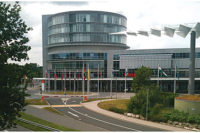The global chemicals industry is expected to reach $5.5 trillion by 2015, according to a new report by Global Industry Analysts Inc. A mature industry with pockets of growth, the global chemical market is highly susceptible to changes in economic scenario, fluctuating feedstock prices, tightening regulations and intense pressure to contain environmental fallout. Though demand continues to fall across mature developed regions, rapid expansion in emerging markets such as China and India is likely to offset the trend. The industry faces challenges due to stringent carbon emission policies and regulations that are driving producers to shift away from petrochemical-based feedstock.
Chemicals form a vital component of the global economy, finding use in virtually every man-made product. Growing interdependence of economies due to increasing international trade is resulting in an industry that is highly globalized in terms of production and supply. The global chemicals industry registered decelerating growth in 2009 due to the recession. Production contracted, as demand from major end-use markets such as construction, automotive, and electronics dropped drastically. Faced with declining demand, chemical producers slashed production, while several plants were either shut down or operated at lower rate to cut costs. Though the economy began recovering from late 2009, chemical production continues to be far below the pre-recession levels.
Developing economies fared better than more mature economies during the recession. The recession led to a distinct structural shift in the global chemicals industry, as production units moved toward Asian countries and new growth markets emerged. As a result, future growth is anticipated from chemical producers in Asia, the Middle East and Latin America, particularly China, Brazil, India, and Korea. Several European and U.S. companies are increasingly setting up or transferring production bases to low-cost locations. The change is also driven by the increasing emphasis of U.S., Japanese and European companies on specialty chemicals, rather than the bulk/commodity chemicals segment, as part of efforts to compete with low-cost manufacturers by moving up the value chain.
While chemical companies from emerging markets focused on transformational M&A transactions, established players have opted for transactions that facilitate portfolio optimization. China is emerging as a major player in the global chemical industry, primarily due to the large affluent middle-class population, rapid urbanization trend, and supportive government policies. The country is becoming a favored destination for global and regional chemical majors due to its manufacturing capabilities and low labor costs. The Middle East, which is another potential growth region, is presently witnessing enormous investments, new capacity additions and intense M&A activity. The region holds an edge due to the low cost of hydrocarbon feedstock as a result of its widespread access to crude oil reserves.
The specialty chemicals segment is expected to report substantial growth in the near future. Factors such as the emergence of new end-use applications, the expanding scope of various applications, and an emphasis on innovations for producing safe and efficient chemicals favor segment growth. However, the market faces challenges due to environmental concerns, rising raw materials prices and regulatory issues.
For more information or to access the report, visit www.strategyr.com/Chemicals_Industry_Market_Report.asp



